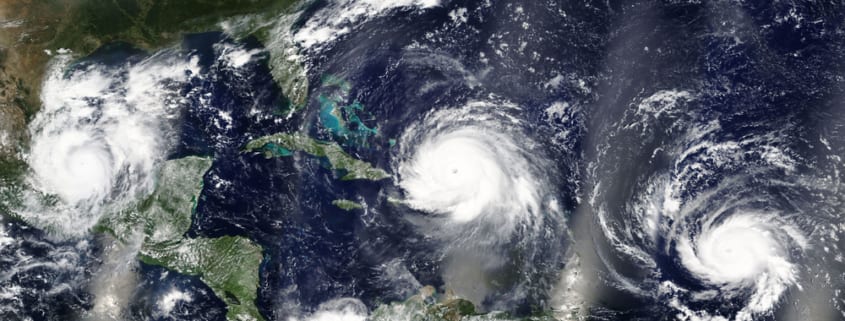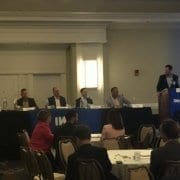How Hurricane Season Can Affect the Commercial Real Estate Industry
Officially, hurricane season is June 1st through November 30th. This is the time of year when tropical storms and hurricanes form in the Atlantic Ocean, due to the difference between sea surface temperature and air temperature. On average, 10 storms occur each year with 6 turning into hurricanes and 2 or 3 becoming Category 3 or higher. The season peaks between mid-August and the end of September (i.e. right now), which is when all of the top 10 costliest storms have occurred in the past. Three of those top five costliest storms occurred in 2017 (Harvey, Irma, and Maria), giving us just a taste of what’s to come in 2018.
Reports came out this summer estimating the potential for costly damage from the 2018 hurricane season. According to analysis by CoreLogic, almost 7 million homes in the US are at risk of hurricane storm surge damage, representing a potential $1.6 trillion in reconstruction costs. That price tag is 6.6% higher than last year due to higher construction costs, equipment, and labor costs. And according to a 2017 report by the National Oceanic and Atmospheric Administration, the national average frequency of high-tide flooding is twice what it was 30 years ago due to rises in sea level, which exacerbates the potential for damage from hurricanes.
Although you most frequently hear about residential properties bearing a brunt of the destruction, commercial spaces and infrastructure are equally as vulnerable and can also experience devastating damage. A recent report by NREI found that the long-term effect of hurricanes on commercial real estate value is often longer than one would typically think. Across all commercial property types, a hurricane decreases values by about 6% in the first year, but that impact rises to 10.5% in the second year. The length of the commercial real estate cycle means that it may take a while for the impacts to be fully felt.
The location and power of a hurricane play a significant role in determining its eventual impact. For example, a low-intensity storm hitting a highly-populated area can be more devastating than a high-power storm making landfall on sparsely inhabited coastline. The four greatest risks during a hurricane are high wind speeds, storm surges, torrential rain, and tornadoes. Most commercial properties, particularly along the Atlantic and Gulf Coasts, have been built to withstand hurricane-force winds and are constructed several feet above water level, but they are still susceptible to extreme flooding or even damage from fallen trees or debris. For example, 2017’s Category 4 Hurricane Harvey dumped an estimated 19 trillion gallons of water into Southeast Texas, leaving billions of dollars in property damage. Older properties are more vulnerable to damage, as well as those located closer to streams, rivers, lakes, or other bodies of water. Additionally, infrastructure typically requires extensive repairs as well.
Beyond damage, there are also more lasting ways that hurricanes can impact the CRE industry, long after hurricane season is over.
Hotels – While hospitality properties will see a brief period of high demand due to displaced people, federal disaster assistance workers such as FEMA, and clean-up contractors, they will likely see a sharp drop in tourism and business visitors.
Multifamily – Demand for short-term and month-to-month housing will increase, at least temporarily. However, new construction projects will likely be halted, making the market even more competitive and driving rent costs to a premium. Unsurprisingly, out of all property types, apartments saw the least short-term impact, with property values down only 5.4%. However, after two years, their values were down by almost 16%. Similar to hotels, rental properties see short-term demand from displaced families, emergency workers, and construction workers, but after two years, reconstruction will be complete, residents can return to homes that are now livable, and workers will leave the area.
Office & Retail – Power outages and inoperable properties can cause a loss of income from decreased productivity, as well as result in a lower contribution to the local economy. Further, it may be months before buildings return to pre-storm capacity, and higher gas prices, store closings, and other damage will depress retail spending. And while e-commerce spending may be up, logistics required by warehousing will be heavily affected. Compared to other property types, office buildings saw the greatest short-term impact, with a value that was down 32% after one year. However, in general, the impact on property values for offices, retail, and industrial is weaker because people still need to work and still need to buy consumer products.
Industry-Wide – Hurricanes causing tens of billions of dollars in damage can affect banking and insurance as well, driving up rates down the line (these expenses often get passed through to tenants and renters). Further, an increase in mortgage defaults means lending restrictions typically tighten, and future projects will require a higher amount of capital to get started. A labor shortage can also delay the amount of time it takes to complete repairs in affected markets and cause building costs nationwide to skyrocket due to increased demand for both materials and labor. This shortage means that new construction projects across the country will be halted or delayed, since the limited labor supply will be focused on reconstruction in damaged areas.
Lastly, locations that have already sustained any sort of hurricane damage carry a long-term stigma, impacting investments and new construction projects for many years to come as the market tries to determine whether the region is more likely to be hit by another storm. The length of the recovery period varies based on the cities impacted and extent of damage. In the meantime, investors are more likely to shift their portfolios to less risky destinations or require a higher rate of return.
The warming climate is driving record-breaking numbers of extreme weather events. Just last year, the US experienced the most billion-dollar natural disasters in history. As hurricane seasons continue to intensify year after year, the commercial real estate industry may see changes such as new building codes, more seasonality in certain markets, or even different policies around insurance and lending.
To learn what other factors may impact the CRE market, check out our free ebook!











